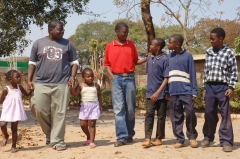You are here
Celebrating Rights of the Child: Social service workforce helps all children realize their rights

 Authored by Thomas Fenn, Senior Adviser, HIV/AIDS; Peter Gross, Child Protection Specialist (Alternative Care); and Jennifer Yablonski, Social Protection Specialist, at UNICEF.
Authored by Thomas Fenn, Senior Adviser, HIV/AIDS; Peter Gross, Child Protection Specialist (Alternative Care); and Jennifer Yablonski, Social Protection Specialist, at UNICEF.
Today we celebrate the 26th anniversary of the UN Convention on the Rights of the Child. This presents a timely occasion to consider the increasingly important role the social service workforce has in helping all children realize their rights. The social service workforce globally includes community volunteers, care workers in child care facilities, paraprofessional social workers and specialized social workers employed by governments.
The Sustainable Development Goals (SDGs) adopted by world leaders gathered at the UN in New York in September 2015 present a major opportunity to strengthen child protection – and for this the social service workforce is a critical component. For the first time ever a number of clear child protection-related targets are part of the global development agenda. And, as will be discussed, a well-resourced and accessible social service workforce is well-placed to help meet the global goals and targets.
SDG 16 ‘Promote peaceful and inclusive societies for sustainable development’ includes target 16.2 ‘End abuse, exploitation, trafficking and all forms of violence against, and torture of, children’. SDG 8 ‘Promote inclusive and sustainable economic growth, employment and decent work for all’ includes target 8.7 which focuses on ending child labour, including child recruitment and use of child soldiers. In SDG 1 ‘Ending poverty in all its forms everywhere’, target 1.3 is particularly relevant to the social service workforce. This target aims to ‘implement nationally appropriate social protection systems and measures for all, including floors, and to achieve substantial coverage of the poor and the vulnerable by 2030.’
UNICEF works worldwide to protect and promote the rights of children and their families, providing critical support to national and sub-national programs and civil society efforts, including to reduce the vulnerability of children across multiple sectors. UNICEF’s #ENDviolence initiative, launched in 2013, connects well to the SDGs. It aims to end one of the most universal child protection experiences, and which can have a devastating impact on current and future lives, that of violence. For example, 85% of all children have experienced violent discipline. As part of UNICEF’s efforts to strengthen the evidence base on what works to prevent and respond to violence against children, the ‘Ending Violence Against Children: Six Strategies for Action’ was developed. The six strategies include 1) supporting parents, families and caregivers, 2) helping children and adolescents manage risks and challenges, 3) changing attitudes and social norms that encourage violence and discrimination, 4) promoting and providing support services for children, 5) implementing laws and policies that protect children, and 6) carrying out data collection and research. As will be explored below, community volunteers, care workers in child care facilities, paraprofessional social workers and specialized social workers –all those who comprise the social service workforce - play an important role in implementing many of these strategies.
Child protection is not about violence alone. There are other areas for which the social service workforce is required. Children may be separated from their parents (placed in alternative care) for various reasons including becoming orphaned, or they may interact with the justice system. In 2014, UNICEF data showed that 58 countries have an Alternative Care Policy in line with the Guidelines for the Alternative Care of Children; in 61 countries UNICEF supported improved service provision in relation to justice for children, including psychological support, legal aid and assistance, and child-friendly institutional and community-based capacities.
For these and other child protection issues, the social service workforce plays a critical role in protecting children from violence, exploitation and abuse. For example, they support parents, families and caregivers by strengthening parenting skills, their ability to solve problems and their ability to cope. Social service providers also help children and their families access essential services such as education, health care, HIV-related services, protection services, legal assistance, and government benefits, which in many countries are also administered by social workers. Collaboration between the services is essential because integrated efforts help reduce childhood and family vulnerability.
Thus there are considerable demands on the social service workforce. These demands are compounded by the need for effective social services in both development and humanitarian settings, where providers may face huge pressures in very difficult circumstances. In addition, the proportion of children to social service workers can be challenging – in some countries there may be tens of thousands of children per government social worker. This is why community members and community groups can, and need to, play a crucial role in enabling vulnerable children and their families to access support services, at least until increased investments are made into the social service workforce.
Developing a stronger social service workforce is a major component of strengthening child protection systems to enable society to prevent violence, exploitation and abuse, and to respond appropriately where these occur. Professionals working on the frontlines protecting the most vulnerable children who might otherwise fall through safety nets, and helping them and their families thrive in their communities, deserve our utmost recognition, appreciation and support. The work of the social service workforce helps to directly connect children’s enjoyment of their rights with the achievement of the Sustainable Development Goals.
Photo courtesy of UNICEF.
